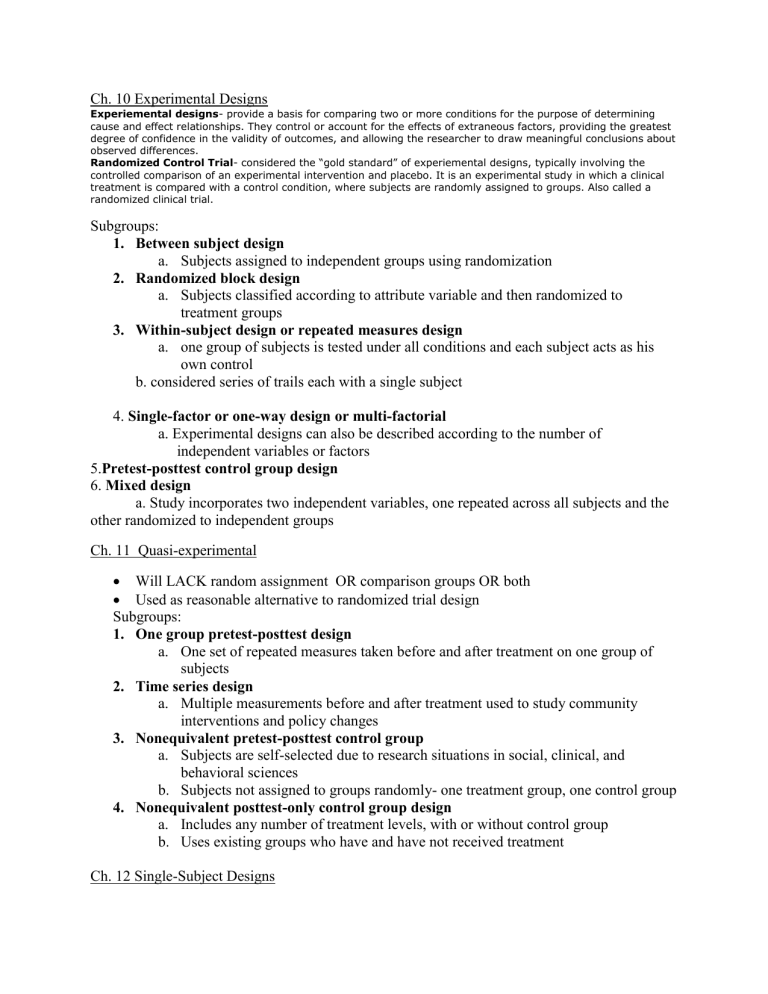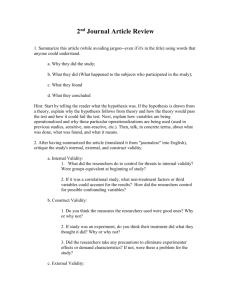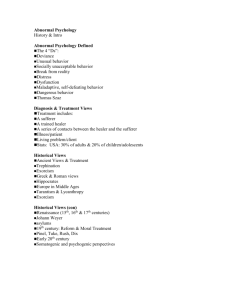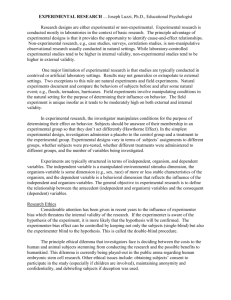Synthesis of Research - DPT-Stats-in-PT

Ch. 10 Experimental Designs
Experiemental designs- provide a basis for comparing two or more conditions for the purpose of determining cause and effect relationships. They control or account for the effects of extraneous factors, providing the greatest degree of confidence in the validity of outcomes, and allowing the researcher to draw meaningful conclusions about observed differences.
Randomized Control Trial- considered the “gold standard” of experiemental designs, typically involving the controlled comparison of an experimental intervention and placebo. It is an experimental study in which a clinical treatment is compared with a control condition, where subjects are randomly assigned to groups. Also called a randomized clinical trial.
Subgroups:
1.
Between subject design a.
Subjects assigned to independent groups using randomization
2.
Randomized block design a.
Subjects classified according to attribute variable and then randomized to treatment groups
3.
Within-subject design or repeated measures design a.
one group of subjects is tested under all conditions and each subject acts as his own control b. considered series of trails each with a single subject
4. Single-factor or one-way design or multi-factorial
a. Experimental designs can also be described according to the number of
independent variables or factors
5.
Pretest-posttest control group design
6. Mixed design a. Study incorporates two independent variables, one repeated across all subjects and the other randomized to independent groups
Ch. 11 Quasi-experimental
Will LACK random assignment OR comparison groups OR both
Used as reasonable alternative to randomized trial design
Subgroups:
1.
One group pretest-posttest design a.
One set of repeated measures taken before and after treatment on one group of subjects
2.
Time series design a.
Multiple measurements before and after treatment used to study community interventions and policy changes
3.
Nonequivalent pretest-posttest control group a.
Subjects are self-selected due to research situations in social, clinical, and behavioral sciences b.
Subjects not assigned to groups randomly- one treatment group, one control group
4.
Nonequivalent posttest-only control group design a.
Includes any number of treatment levels, with or without control group b.
Uses existing groups who have and have not received treatment
Ch. 12 Single-Subject Designs
Must have a collection of repeated measurements of a behavioral response over time
Must have 2 testing periods or phases: baseline and intervention
Subgroups:
1.
Withdrawal design a.
Includes a second baseline and maybe a second intervention
2.
Multiple baseline designs
3.
Alternating treatment design
4.
Multiple treatment design
Chapter Outlines
Observational-study that does not involve an intervention or a manipulation of an independent variable.
Exoploratory research-research that has as its purpose the exploration of data to determine relationships among variables
RETROSPECTIVE AND PROSPECTIVE RESEARCH:
Prospective research- study designed to collect data following development of the research question
Retrospective research- study that analyzes observations that were collected in the past.
LONGITUDINAL AND CROSS-SECTIONAL RESEARCH:
Longitudinal Research- study designed to collect data over time, usually the purpose of describing developmental changes in a particular group.
Cross-Sectional Research- study based on observations of a different age or developmental groups at one point in time, providing the basis for inferring trends over time.
COHORT STUDIES:
Cohort study- an observational study design in which a specific group is followed over time. Subjects are classified according to whether they do or do not have a particular risk factor or exposure and followed to determine disease outcomes.
Prospective- study designed to collect data following development of the research question
Retrospective- study that analyzes observations that were collected in the past.
CASE-CONTROL STUDIES: o Selection of Cases and Controls
Selection of Cases: a.
Population based study- study that obtains a sample of cases from the general population of those with the disorder
b.
Hospital based study- study in which cases are obtained from patients in a medical instituiton.
Selection of Controls- controls can be selected from several sources. They are often recruited from the same hospital or instiutution as the cases, from
those admitted for conditions other than the disease of interest.
CORRELATION AND PREDICTION:
Correlation- measure of the degree of association between variables.
Correlational research- descriptive research approach that explores the relationship among variables without active manipulation of the variables by the researcher.
Predictive Correlational Study- study designed to predict a behavior or response based on the observed relationship between the behavior and other variables
Regression Analysis- a statistical procedure for examining the predictive relationship between a dependent (criterion) variable and an independent (predictor) variable
EVALUATING CAUSALITY IN OBSERVATIONAL STUDIES:
Observational study-study that does not involve an intervention or manipulation of an independent variable.
Dose- response relationship- provides evidence for causality. This means that the severity of the disease can be associated with varying levels of exposures.
METHODOLOGICAL RESEARCH: RELIABILITY AND VALIDITY :
Methodological Research- research designed to develop or refine procedures or instruments for measuring variables, generally focusing on reliability and validity. o Reliability-The degree of consistency with which an instrument or rater measures a variable.
Testing the Rater o Validity- The degree to which an instrument measures what it is intended to measure. The degree to which a research design allows for reasonable interpretations from the data, based on controls (internal validity), appropriate definitions (construct validity), appropriate analysis procedures (statistical conclusion validity), and generalizability
(external validity).
Reliability and Validity:
HISTORICAL RESEARCH:
Historical Research- research that seeks to examine relationships and facts based on documentation from the past. a.
External criticism- establishing the authenticity of data. b.
Internal criticism- questions the truth or worth of the material’s content within the context of the research question.
Secondary Analysis- an approach to research involving the use of data that were collected for another purpose, usually for the purpose of testing new hypotheses.
Developmental Research:
Developmental research involves the description and developmental change and the sequencing of behaviors in people over time. In other words, a descritpive research approach designed to document how certain groups change over time on specific variables.
Normative Research:
A descriptive research approach designed to determine normal values for specific variables within a population. Normative studies are often directed toward a specific age group, gender, occupation, culture or disability.
Qualitative Research:
Seeks to descibe the complex nature of humans and how individuals perceive their own experiences within a context. Qualitative research paradigms offer a perspective to explore and understand human behavior that arises from a different philosophy than quantitative research designs.
Qualitative methodology uses the subject’s own words and narrative summaries of observable behavior to express data, rather than numerical data dervied from predetermined rating systems.
Descriptive Surrveys:
Surveys are often used as a source of data to collect information about a specific group, to describe their characteristics or risk factors for disease or dysfunction. These types of studies are generally focused on a particular issue or aspect of the group’s behaviors of attitudes. The purpose of this
approach is to provide an overall picture of the group’s characteristics, but may involve some correlational interpretations regarding association among certain variables.
Case Study
Also known as case report, is used to develop a clinical knowledge base and as a means of sharing special information among professional colleagues. Typically, case studies involve the in-depth description of an individual’s condition or response to treatment; however case studies can also focus on a group, instituition, or other social unit, such as a particular school, health care setting, community or family.
Case series- is an expansion of a case study involving observations in several similar cases.
Data Sources:
Secondary Analysis
An approach to research involving the use of data that were collected for another purpose, usually for the purpose of testing new hypotheses.
Surveys and Questionnaires
Survey is composed of a series of questions that are posed to a group of subjects and may be conducted as an oral interview or as a written or electronic questionnaire. Sometimes the data are intended for generalization to a larger population; other times they may intended as a description of a particular group. Surveys in clinical research are often concerned with describing current practices, attitudes, and values, or chacterisics of specific groups.
Questionnaires are structured surveys that are self-administered using pen and paper or electronic formats. The advantages of using questionnaires are many. They are generally more efficient than interviews because respondents complete them on their own time. Questionnaires are particularly useful as a research method for examining phenomena that can be assessed through selfobservation, such as attitudes and values. They are not as useful for studying behaviors that require objective observation.
Synthesis of Research
Systematic Reviews
Review of a clearly formulated question that uses systemic and explicit methods to identify, select, and critically appraise relevant research. In other words, a systmatic review refers to a rigorous process of searching, appraising and summarizing existing information on a selected topic. Reviews are most
commonly focused on the effectiveness of interventions, but also may address the accuracy of diagnostic tools or identification of prognostic factors.
Meta-Analysis
Use of statistical techniques in a systematic review to integrate the results of included studies to determine overall outcome, usually based on effect size. In other words, it is an extension of the systematic review that incorporates a statistical combination of several studies that have related research hypotheses. Meta-analyses can be done for systematic reviews of clinical trials, evaluation of diagnostic tests or epidemiologic studies.
![study_design_summaries[1]. - DPT-Stats-in-PT](http://s3.studylib.net/store/data/008944321_1-58dbe27b313caaad548a0c6d42476993-300x300.png)









